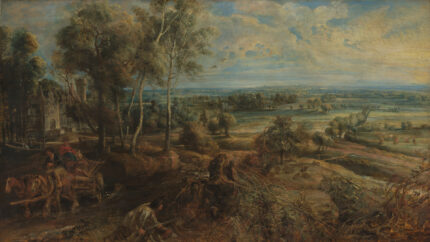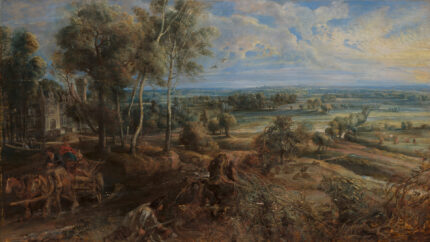London’s National Gallery has cleaned and conserved one of their greatest works by Flemish Baroque master Peter Paul Rubens. View of Het Steen in the Early Morning was dingy and yellowed from discolored varnishes applied by restorers 75 years ago.
Rubens’ commissions were mostly portraits of aristocrats, altarpieces and large-scale historical, Biblical and mythological scenes, but he was also an art collector in his own right and a dedicated student of architecture. His townhouse in Antwerp, now known as the Rubenshuis, was extensively renovated and rebuilt based on his designs for both the exteriors and interiors.
His classical humanist education served him in good stead throughout his career, advancing him socially and professionally above the rank most artists, who no matter how elevated their clientele ultimately worked with their hands, were able to achieve. Habsburg patrons deployed Rubens on diplomatic missions when he travelled to other courts for art commissions. He was held in high esteem for his talents as an artist and as a diplomat, and was knighted by Philip IV of Spain in 1624 and Charles I of England in 1630.
In 1635, Rubens bought the Elewijt Castle, also known as the Castle of Het Steen, in the village of Elewijt 20 miles south of Antwerp. His acquisition of a landed estate was symbolic of his rise in status from artist to courtier and gentleman and he put brush to panel to capture his new demesne. He depicted his manor house and the bustle of activity — ox cart going to market, hunter and dog stalking birds — of a country estate shortly after dawn.
By then his phalanx of students at the workshop in the Rubenshuis had been executing commissions for more than two decades, all designed, overseen and finished by the master, but most of the hands-on work was being done by his employees. A View of Het Steen in the Early Morning is 7.5 feet wide and 4.2 feet high and all of it was painted by Rubens himself, probably to decorate one of the grand rooms of the Het Steen. And thus the artist became his own patron.
The discolored varnishes dramatically altered the Rubens palette, yellowing everything and eliminating the delicate warm gold accents from the sun against the white of the clouds. The contrast of the earth tones in the foreground against increasingly cool blues going backwards in the landscape was flattened as well. Now that it has been cleaned and the old varnish removed, Rubens’ original vision shines through.

